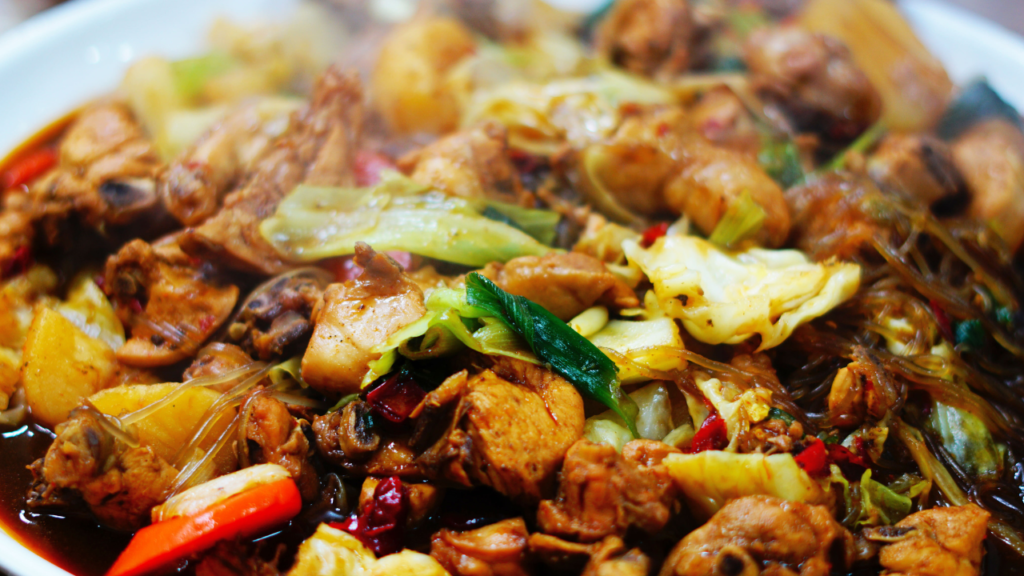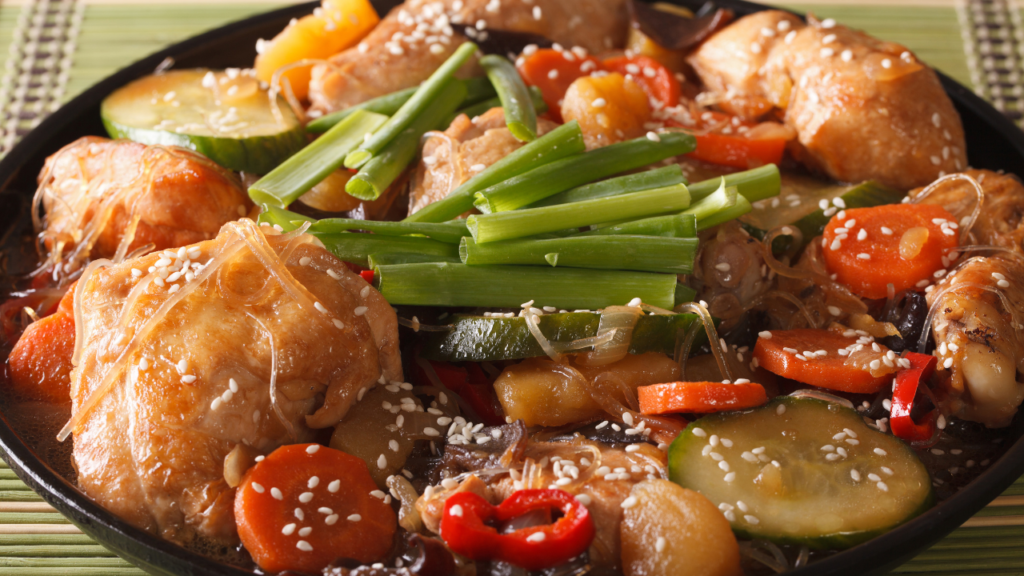Do you know one of the best sweet-spicy chicken dishes in South Korea? No, it is not fried chicken – although that is definitely delicious. It is Andong Jjimdak, a sweet, savoury and spicy dish made of chicken braised with vegetables and sticky (or glass) noodles. Andong Jjimdak originates from Andong, a city in the south of South Korea, and is well-known for being reasonably cheap compared with the quality or value for culinary aspects. The portions are huge and filling because there are so many vegetables in the dish.
Andong Jjimdak is inspired from the traditional Dakjjim and developed as School District Food for students with lots of vegetable. However it is becoming more popular and loved by Andong local and tourists these days. So today, let’s have a look at Andong Jjimdak!

Contents
What is Andong Jjimdak
Andong Jjimdak is spelled 안동 찜닭 in Korean. Andong refers to the city in the south of the country. It is the capital of the North Gyeongsang province and known for its rich culture and folklore. It is a very old and historical city and was very important during Joseon times. These days, Andong city centre is still filled with beautiful old buildings, and there is even a traditional village, 한옥마을, in the city.
찜닭 literally means steam chicken. 찜 refers to dishes that are braised, steamed, or stewed in a sauce, and 닭 means chicken. 찜닭 is thus a common preparation for chicken, but Andong Jjimdak is a special local variety that is the most popular kind of Jjimdak all over the country.
Andong Jjimdak is made by braising large chunks of chicken, vegetables, potatoes, and glass noodles in a spicy soy sauce-based liquid. The ingredients are braised quite long, making them soft and chewy and infused with flavour. Unlike other chicken stews, like Dakbokeumtang(닭볶음탕), no gochugaru (Korean chilli powder) or gochujang (Korean chilli paste) is used, only fresh and dried whole chilies! This gives the dish a nice, fresh kick.
Making the dish is fairly simple. You just need to cut up the vegetables and chicken in even-sized chunks, and add them to the sauce you made earlier. The longer you braise the dish, the better it tastes.
Because the dish uses relatively not expensive ingredients – a whole chicken and seasonal vegetables – restaurants are able to offer large portions for a fair price. This makes it a popular dish among students. Office workers also like to eat Andong Jjimdak for lunch or during a company dinner. The dish is always shared with each other.
We once hosted a food tour for one global famed celebrity chef from France and he said that Andong Jjimdak is the most underrated Korean food, because it is not inferior in taste to any high-end French chicken dish made with the same ingredients and that it is hard to believe that such a great dish can be eaten at such a low price.
Origin of Andong Jjimdak
So, where did Andong Jjimdak come from? Some people think this dish was already eaten during Joseon time (from 1392 to 1897). Andong was the centre of culture during that time, and many rich people lived in the inner city. It is speculated that Andong Jjimdak was only eaten by the rich people (Yangban in Korean) during special occasions. However, there is little to substantiate this rumour.
It is more plausible – and factual – that Andong Jjimdak was created during the 1980s in markets in Andong. During this time, fried chicken shops were becoming more and more popular in the country. The market vendors in Andong’s Dak Golmok (닭골목, which literally means chicken alley) saw less customers coming by, and wanted to make a dish that could rival the Western-style chicken shops.
They used ingredients that were popular locally, like glass noodles, potatoes, and whole chilies, to make a sweet, spicy, and savoury dish. Because it was served very hot, in large portions and for a low price, the dish became popular rapidly. Many people travelled to Andong to try the braised chicken, and the dish ended up becoming popular throughout South Korea.
Nowadays, there are many restaurants all over the country that serve Andong Jjimdak. Usually, you can get a traditional variety, as well as special varieties and less spicy dishes.

Jjimdak Ingredients
Let’s have a look at what goes into Andong Jjimdak. The dish consists of two parts: the sauce, and everything that is braised in the sauce.
1. Andong Jjimdak Sauce
The sauce that is used to braise the ingredients is sweet, savoury, and only slightly spicy. Most commonly it is made using soy sauce, oyster sauce, rice wine, dark brown sugar, Korean Mulyeot (물엿, a very sticky, sirupy sweetener) or corn syrup, pepper, finely minced garlic, minced ginger, sesame oil, and water. This is all combined until you get a dark brown, sticky sauce.
As you can see, there are no chilies in the sauce, not even chilli pepper. The sauce, and thus the whole dish, becomes spicy because whole chilies are braised in the sauce.
2. Main Jjimdak Ingredients
The sauce is then used to braise a variety of ingredients. There are always chunks of chicken, usually with the bone in. The chunks can be fairly large. White potatoes are also added as they really soak up the braising liquid. Carrots, onions, and mushrooms are also chopped up into bite-sized chunks, roughly the same size as the chicken. Korean glass noodles, which are made from sweet potato starch, are also added to provide some carbs. These noodles are very chewy and soak up the sauce. Scallions and sesame seeds are used to garnish the dish.
The secret ingredient in Andong Jjimdak are whole chilies. Dried and fresh chilies are added whole, to give off a spicy flavour to the whole dish. During the braising, the spice slowly leaks out into the sauce, making the whole dish taste fresh and spicy. This is a very different kind of spice from Korean gochugaru (red pepper powder) and gochujang (red pepper paste).
How To Make Andong Jjimdak & Recipe
Combine all the ingredients for the sauce before you start the cooking process. The earlier you do it, the longer the flavours have to set. Parboil the chicken in a pot for 1 minute to skim off any fat. Drain the water and add the sauce. Cook together on a medium-high heat for about 10 minutes. Add the potatoes, carrots, onions, and all the chilies and boil for 7-10 more minutes. Reduce the heat, stir well and cook for 10 more minutes. Remember, the longer you cook, the more the flavours will permeate all ingredients!
Add the mushrooms and glass noodles and cook for another 3-5 minutes, or until the ingredients are ready. Garnish with the scallion and sesame seeds. Andong Jjimdak is best eaten with some plain white rice.
Variations of Jjimdak
There are not many variations of Andong Jjimdak because it is quite a new dish. Nevertheless, you can often find different kinds of Jjimdak in restaurants. Some restaurants offer the dish with boneless chicken – way easier to eat but some people find that chicken with bones has a superior taste. The Jjimdak can also be made less spicy, or the sauce less dark. Leafy greens like spinach and bok choy are also sometimes added to give the dish some texture.
Recently, cheese Jjimdak has become popular too. Cheese is added on top of the dish right before serving, so that it melts and becomes soft. It pairs nicely with the spicy sauce as it creates a balance. Opinions are divided, however, because the dish is quite sweet and not everyone likes the combination of cheese and sweetness.
Best Jjimdak Restaurants in Seoul
Luckily, you do not have to travel all the way to Andong to try Andong Jjimdak, although you definitely should if you have the time! Seoul also has plenty of nice restaurants that serve really good, authentic Andong Jjimdak.
There are two main chain restaurants that serve Andong Jjimdak all over Seoul. The first must-try is called, surprisingly, Andong Jjimdak. It serves large portions of Andong Jjimdak, both with bones and boneless, accompanied by kimchi and dongchimi. Especially the dongchimi is really nice as it counters the sweet, greasy taste. This version of Andong Jjimdak is not very spicy, so good if you are not a big fan of spicy food.
Another famous restaurant is Bongchu Jjimdak. They also serve huge portions of the dish, and their sauce is generally seen as a little cleaner and lighter. It is also not a very spicy variant of Andong Jjimdak. Dongchimi and kimchi are served on the side.
There are many more Andong Jjimdak places in Seoul, every neighbourhood has its own place! The best way to find a nice restaurant is to ask your colleagues or fellow students. Or, go to Myeongdong. There are many Andong Jjimdak restaurants in Myeongdong as it is a popular tourist dish.
